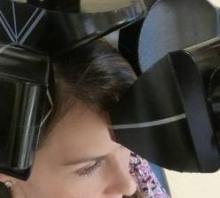PHILADELPHIA – An investigational, four-coil device for transcranial magnetic stimulation deep in the brain produced some striking cases of sustained pain relief when it was tested on five fibromyalgia patients in a pilot study.
Based on these promising early results, the next step will be a larger, controlled study, involving about 40 fibromyalgia patients, Dr. M. Bret Schneider said at the annual meeting of the American Psychiatric Association.
The new device for repetitive transcranial magnetic stimulation (rTMS) builds on the premise of a TMS device marketed by NeuroStar and approved by the Food and Drug Administration for treating depression. Instead of the single coil used in the NeuroStar device to create a pulsating magnetic field and produce an electrical current within a patient’s prefrontal cortex, Dr. Schneider and his associates designed a four-coil device to target a deeper brain region, much like a Gamma Knife used for radiosurgery. Their target was the dorsal anterior cingulate, a region of the brain linked with chronic pain. The concept was to stimulate the cingulate to produce a noninvasive cingulotomy, a surgical procedure occasionally performed to sever white-matter connections to the cingulate and provide pain relief to patients with intractable, chronic pain.
Dr. Schneider cofounded a company (Cervel Neurotech) to develop this device. The first step was to test several different four-coil arrays on healthy volunteers to identify the orientation that appeared to produce the greatest effect within the dorsal anterior cingulate, based on the treatment’s impact on cingulate metabolism measured with oxygen-15 PET scanning.
The developers next took the most promising orientation and applied it using two different treatment modes in a study that included a total of 45 fibromyalgia patients with chronic, intractable pain. Some patients in the study received treatments with a different coil orientation, or sham treatments.
The best results occurred in five patients who received the highest frequency of magnetic pulses, 10 Hz in the best-performing coil orientation. These patients had a treatment course that involved 10 pulses per second for 4 seconds, followed by a 26-second pause, and then a repeat. Each daily treatment session included 75 of these repeated courses (a total treatment time of 37.5 minutes). Patients received this daily session 5 days a week for 4 weeks, and then their residual pain levels off treatment were measured using the BPI (Brief Pain Inventory) 3 days after their last session, and then 4 weeks after their last treatment session. The researchers also performed BPI measures on each patient at baseline, and on each of the 20 days when each patient underwent treatment.
The results showed that all five patients averaged a steady drop in their pain levels over the course of the 4-week treatment, and that their pain fell even further when measured after their treatment finished. Their lowest pain level occurred at the 4-week follow-up, when they showed an overall average 45% drop in their pain scores, compared with baseline. Individually, "some of the patients had complete pain relief, while others less so," said Dr. Schneider, who is also a psychiatrist and neurosurgeon at Stanford (Calif.) University.
The treatment appeared safe, with fewer adverse effects reported by patients who received any of the active treatments, compared with those who received sham treatments. The most common, treatment-associated adverse effects were mild episodes of headache, nausea, and scalp pain, he said.
The presumed mechanism of action is that the sessions of rTMS produce long-term potentiation in the cingulate, Dr. Schneider said in an interview. During rTMS treatment, neurons in the cingulate rapidly fire, but once treatment stops, the activity in the cingulate appears to fall below the basal level. The researchers documented this with their 15O PET studies, which showed that following rTMS, the dorsal anterior cingulate has reduced blood flow and metabolic activity. This reduced cingulate activity might explain the pain relief that patients reported, Dr. Schneider said.
The study was funded by Cervel Neurotech, the company developing this new device. Dr. Schneider is a founder, employee, and stockholder of the company.



